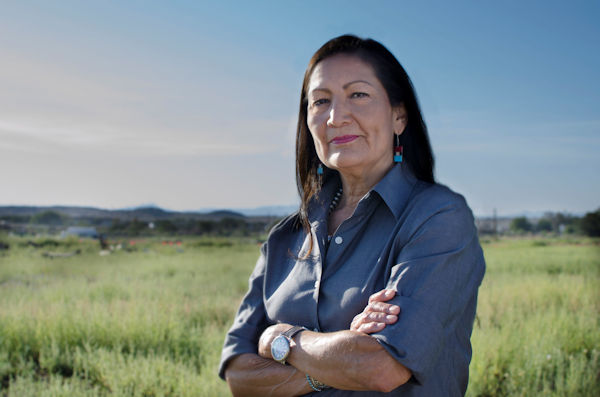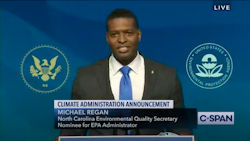SEJournal Online is the digital news magazine of the Society of Environmental Journalists. Learn more about SEJournal Online, including submission, subscription and advertising information.
 |
| Rep. Deb Haaland, above, slated to join Biden’s cabinet as the first Native American Interior secretary, will play a key role in federal decisions on energy, environment and climate, along with other major Biden nominees. Photo: debforcongress.com. Click to enlarge. |
Issue Backgrounder: Biden Nominees Foretell Aggressive Action on Climate, Environmental Justice
EDITOR'S NOTE: This story is one in a series of special reports from SEJournal that looks ahead to key issues in the coming year. Visit the full “2021 Journalists’ Guide to Energy & Environment” special report for more.
By Joseph A. Davis
 |
Incoming President Joe Biden has already named his most important picks for environment and energy posts in the new administration, and they signal clearly key policy directions, particularly on climate.
His main picks in the climate arena signal determination to take an aggressive approach. But Biden’s whole-of-government approach to climate change will mean heads of almost all agencies will need to play ball on the issue.
And the bare Democratic majorities in the Senate and House should allow him to get most of those who need confirmation to get it quickly — and will improve his chances of getting major parts of his climate plan passed by Congress.
Meanwhile, his agency heads at the U.S. Environmental Protection Agency and Department of Interior will have to slog through the restoration of piles of regulatory rollbacks. Despite that, they may actually be able to leapfrog the de-Trumpification process by taking up a new generation of issues.
Here are some key selections, with early indications of their focus.
Kerry as international envoy on climate
Former Secretary of State John Kerry will be climate envoy, representing the president as point man in the international arena (in a post that needs no Senate confirmation). But getting the United States back into the Paris Agreement will be the easy part.
Under the Obama administration, Kerry played a major role in getting the agreement signed in the first place before Trump made the United States the only nation in the world to pull out. Since it was written in such a way that Senate action is not required to ratify it, once Biden ratifies it again, the country is back in.
The Paris pact needs to be pumped up and
strengthened if the world is to have any hope of
getting a grip on climate and preventing worse disaster.
The problem is that the Paris pact needs to be pumped up and strengthened if the world is to have any hope of getting a grip on climate and preventing worse disaster (may require subscription).
It’s easy to forget — as big a greenhouse gas emitter as the United States actually has been — that the climate change problem will not be solved without global action. So one of Kerry’s biggest challenges will be helping convince a lot of other nations to do more to check greenhouse gas emissions. That takes diplomatic persuasion.
The U.N. climate effort is chronically plagued by many other issues that call for the utmost diplomatic skill. For example, developing nations say the industrialized nations have done most of the damage already, and so believe they are owed financial aid for clean-energy development or conservation of forests and other carbon sinks.
McCarthy to serve as national climate advisor
You may remember Gina McCarthy as administrator of the U.S. Environmental Protection Agency under President Obama. Biden has appointed her to a White House position (also not needing Senate confirmation) to oversee climate action at virtually all federal agencies.
[Editor’s Note: McCarthy will be the keynote speaker at the Society of Environmental Journalists’ annual look ahead at key energy and environmental issues, hosted virtually by National Geographic Society and co-sponsored by the Wilson Center, Jan 27. Get details and register.]
 |
| McCarthy with then-Vice President Biden in 2015. Photo: National Archives. Click to enlarge. |
When the Obama administration almost got the Waxman-Markey climate bill through Congress in 2009, but failed in the Senate, Obama opted to do all he could using just his administrative powers. Under McCarthy, EPA came up with the Clean Power Plan (may require subscription), a flexible and creative regulatory regime that pushed electric power utilities to lower their carbon dioxide emissions.
Utilities, especially coal-fired generators, did not like it, because it made new coal plants almost impossible to build. They cheered the Trump EPA, which replaced it with a much weaker plan.
But, like a miracle, coal plants continued to close, and wind and solar prospered. Several studies in later years found that the United States would meet the goals of the Clean Power Plan without the regulatory regime itself.
One main reason for this was the falling price of natural gas, made cheap by the fracking revolution. Plants converted from coal to gas because it was cheaper and reduced their CO2 emissions in the process.
So the battlefield McCarthy will oversee is very different today. If the economy recovers and Trump trade barriers subside, wind and solar will compete well on their falling cost.
Yet big challenges remain to make renewables more useful, including improvements in storage technology and beefing up the transmission grid. That means overcoming all kinds of technological and local obstacles. Large amounts of federal spending could help — and would create more of those “green jobs” Biden talks so much about.
Moreover, from her perch at the White House, McCarthy can enlist many other federal agencies in the fight. Today, some of the biggest fractions of U.S. greenhouse gas emissions come from heating in the building sector and from transportation via the internal combustion engine. That means involving the Departments of Energy, Transportation, Housing and Urban Development, and more.
And while the emissions from burning natural gas (fossil methane) are important, the emissions from leaking it are also bad. Trump repealed (may require subscription) rules controlling methane leaks. Restoring them will involve not just EPA, but the Interior Department, which oversees gas operations on federal lands.
Regan a battle-tested EPA administrator
Michael Regan, whom Biden has picked (may require subscription) for the position (this one needing Senate confirmation) of administrator of the EPA, has been battle-tested. He has headed the North Carolina Department of Environmental Quality as secretary.
 |
| Regan at a Dec. 19, 2020, event for the Biden climate team. Image: C-SPAN. Click to enlarge. |
North Carolina is a roost (electrically speaking) largely ruled by Duke Energy. Until recently, Duke was all about coal. That is why coal-ash disposal (and pollution therefrom) has been a big issue historically in the state ... and Regan’s headache. In January 2020, Regan closed the largest-ever coal-ash cleanup deal in history, in which Duke agreed to excavate almost all of its coal-ash disposal sites.
There’s more. In North Carolina, Regan created the state’s Environmental Justice and Equity Board, which advises the governor. Environmental justice has gotten short shrift at the Trump EPA, and is a top priority for Biden. It was organized groups of young climate activists, like the Sunrise Movement, who have made environmental justice a major issue for Biden as they helped him win the White House.
While EPA Administrator Lisa P. Jackson was the first African American to head EPA, from 2009-2013, Regan would be the first Black man. Regan previously worked at EPA in the air office from 1998-2008, during both the Clinton and Bush administrations. He worked at the Environmental Defense Fund from 2008 to 2016.
Haaland a historic choice for Interior
Biden’s choice of Rep. Deb Haaland (D-N.M.) for secretary of the Interior is a historically big deal. If confirmed, Haaland, who was only elected to Congress in 2018, will be the first Native American Interior secretary (and the first Native American in the cabinet). In her House bio, she refers to herself as “a 35th generation New Mexican who is an enrolled member of the Pueblo of Laguna.”
The Interior Department is a sprawling and complex multitasking agency. It has a crucial role in overseeing federal lands, waters, minerals and natural resources. It also contains the Bureau of Indian Affairs, which (let’s face it) has been the contact point where the federal government has often genocidally mistreated tribal nations and violated its treaty obligations. Her nomination strikes a note of hope that U.S.-tribal nation relations can be improved.
As overseer of public lands and natural resources, Haaland would have a key role in federal decisions on energy, environment and climate. The main federal agencies for oil and gas leasing, the Bureau of Land Management and the Bureau of Ocean Energy Management, are both under Interior’s purview.
BLM in many cases does the actual leasing for federal agencies not under Interior’s direct supervision, like the U.S. Forest Service (which is under the Department of Agriculture).
Recent years have shown how crucial Native Americans
are in pipeline decisions. That’s partly because they
own vast swathes of the American West.
When it comes to pipelines, the oil and gas industry will tell you that they are important to the nation’s energy diet, while environmentalists will tell you that they promote fossil fuel consumption and harm the climate. While pipelines are regulated by a host of agencies (the Federal Energy Regulatory Commission being only one) — recent years have shown how crucial Native Americans are in pipeline decisions. That’s partly because Native Americans own vast swathes of the American West, including waters that pipelines have to cross to get from where the oil is to where it can be sold.
These pipelines have become flashpoints in the regulatory war over fossil fuels themselves. Just as the Keystone XL pipeline politically galvanized and united the environmental movement in recent decades, the Dakota Access Pipeline galvanized and united Native tribes to a degree not seen before.
The DAPL protest-occupation at the Standing Rock Indian Reservation drew together many tribal nations, strengthening a continent-wide Native movement. (Haaland was there at Standing Rock, cooking green chili and tortillas for the water protectors.)
The Interior Department that Haaland would head also oversees National Monuments. When the Trump administration slashed the size of national monuments set aside by Obama in 2017, it was the Interior secretary who did the deed. Many of the lands stripped of protection (e.g., in Bears Ears) were sacred to tribal nations. Conservationists hope Haaland and Biden will put these lands back in protected monument status. Biden has promised to do so.
Before the Democrats took control of the Senate, some worried that she would be hard to confirm. With effective Democratic control, she is likely to make it.
Other key environment-energy picks
Few appreciate how many federal agencies are involved in environment and energy issues. Biden has not named picks for all of the leadership slots at these agencies. But he has announced some.
A key post is at the Department of Energy, for example, where he has selected former Michigan Gov. Jennifer Granholm (D) as head. Her auto-industry ties may ease the transition to cleaner cars.
To chair the White House Council on Environmental Quality, he has named Brenda Mallory, who actually served as general counsel at CEQ during the Obama years. Mallory, who would be the first African American to run the office, has a wide background in environmental law and has litigated for environmental justice.
At CEQ, she would be in charge of restoring the damage done by Trump rulemaking to the National Environmental Policy Act, which could be a key tool for Biden in mobilizing the federal machinery for climate action.
Track other key appointments in the weeks to come via SEJ’s curated story service at EJToday (subscribe here).
Joseph A. Davis is a freelance writer/editor in Washington, D.C. who has been writing about the environment since 1976. He writes SEJournal Online's TipSheet, Reporter's Toolbox and Issue Backgrounder, as well as compiling SEJ's weekday news headlines service EJToday. Davis also directs SEJ's Freedom of Information Project and writes the WatchDog opinion column and WatchDog Alert.
* From the weekly news magazine SEJournal Online, Vol. 6, No. 3. Content from each new issue of SEJournal Online is available to the public via the SEJournal Online main page. Subscribe to the e-newsletter here. And see past issues of the SEJournal archived here.













 Advertisement
Advertisement 



